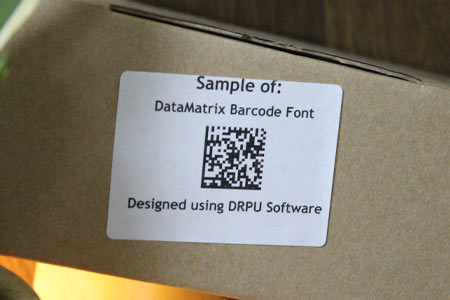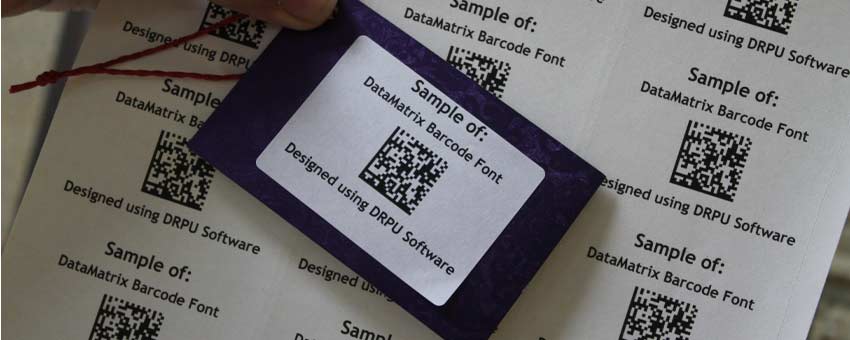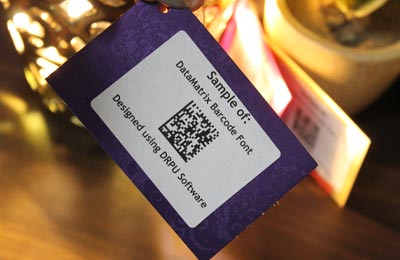History of DataMatrix Barcodes
The DataMatrix barcode was developed by International Data Matrix, Inc. (ID Matrix) in the 1990s as a high-density barcode that could be printed on small items, such as electronic components. The first patent for the DataMatrix barcode was issued in 1997. Since then, the DataMatrix barcode has become widely used in many industries, including the automotive, aerospace, and pharmaceutical industries.
How DataMatrix Barcodes Work❖ DataMatrix barcodes encode data by varying the arrangement of black and white cells in a two-dimensional grid. The cells are arranged in a square or rectangular pattern, and the number of cells in the pattern can vary depending on the amount of data to be encoded. Each cell can be either black or white, and the cells are grouped into clusters, with each cluster representing a single data point.
❖ The scanner captures an image of the barcode and analyzes the pattern of cells to extract the encoded data. Because DataMatrix barcodes can be read from any direction, they are often used in situations where the orientation of the barcode may vary, such as on small parts or on curved surfaces.
Purpose Of Using DataMatrix Barcode

The purpose of using a DataMatrix barcode is to efficiently and accurately store and retrieve data in a compact and secure format. A DataMatrix barcode is a two-dimensional barcode that consists of a matrix of black and white cells, which encode data in a way that can be read by barcode scanners and other devices. The data encoded in a DataMatrix barcode can include text, numbers, and binary data such as images or multimedia files.
One of the key advantages of DataMatrix barcodes is their high data capacity. DataMatrix barcodes can encode up to 3,000 alphanumeric characters or 7,000 numeric characters, which is much higher than other types of barcodes such as UPC or EAN codes. This makes DataMatrix barcodes ideal for encoding large amounts of data in a small space.
Another advantage of DataMatrix barcodes is their high level of data security and robustness. The matrix design of DataMatrix barcodes allows them to be printed on curved or uneven surfaces, and they can still be scanned from any angle. DataMatrix barcodes can also be printed with a range of materials and technologies, including laser printing, inkjet printing, and direct part marking, which makes them highly durable and resistant to damage.
In addition, DataMatrix barcodes can be read by a range of devices, including handheld barcode scanners, mobile devices, and machine vision systems. This makes them highly flexible and adaptable to a range of different applications and environments.
DataMatrix barcodes are used in a wide range of industries and applications where space is limited, and a high level of data security and robustness is required. Some common uses of DataMatrix barcodes include:
-
Product Identification:
DataMatrix barcodes are often used to encode product information, such as serial numbers, part numbers, and other identifying information. This can help to track products throughout the supply chain and ensure that the right product is delivered to the right place at the right time.
-
Asset Management:
DataMatrix barcodes are also used for asset management, allowing companies to track the location and movement of equipment, tools, and other assets. This can help to reduce losses and improve efficiency by ensuring that assets are used where they are needed and when they are needed.
-
Medical Records:
DataMatrix barcodes are commonly used in the healthcare industry to encode patient data, medication information, and other medical records. This can help to improve patient safety by ensuring that accurate and up-to-date information is available to healthcare providers at all times.
-
Logistics:
Reading Devices:
DataMatrix barcodes are used in logistics to track and trace products throughout the supply chain, from the manufacturer to the end consumer. This can help to improve efficiency by providing real-time visibility into the location and status of products in transit.
-
Document Management:
Reading Devices:
DataMatrix barcodes are also used for document management, allowing companies to store and retrieve documents quickly and efficiently. This can help to reduce paper-based processes, improve data security, and streamline workflows.
Overall, the purpose of using a DataMatrix barcode is to efficiently and accurately encode and retrieve data in a compact and secure format. DataMatrix barcodes are widely used in a range of industries and applications, including product identification, asset management, medical records, logistics, and document management. Their high data capacity, data security, and flexibility make them an ideal solution for a wide range of data management and tracking needs.
Industries Commonly Use DataMatrix Barcodes
DataMatrix barcodes are used in a variety of industries and applications. Because they are versatile, compact, and capable of encoding a wide range of data types, DataMatrix barcodes have become a popular technology for use in many different settings. In this article, we will explore some of the industries that commonly use DataMatrix barcodes and the specific ways in which they are used.
-
Food Industry
DataMatrix barcodes are used in the food industry for tracking and managing products or food items. By encoding product information such as expiration dates, lot numbers, and nutritional information into DataMatrix barcodes, food companies can track products or items from the farm to the table. This helps to reduce food waste, improve food safety, and streamline supply chain logistics.
-
Manufacturing Industry
DataMatrix barcodes are used in the manufacturing industry for inventory management and product tracking. By encoding product information such as part numbers, serial numbers, and manufacturing dates into DataMatrix barcodes, manufacturers can track products from the assembly line through the supply chain. This allows manufacturers to monitor inventory levels, manage logistics, and improve quality control.
-
Automotive Industry
DataMatrix barcodes are used extensively in the automotive industry for tracking and identifying parts. Each part in a vehicle may have a unique DataMatrix barcode that identifies its manufacturer, production date, and other important information. By using DataMatrix barcodes, automakers can ensure that parts are manufactured to the correct specifications and that they are installed in the correct location.
-
Logistics Industry
The logistics industry relies heavily on DataMatrix barcodes for tracking and managing shipments. By encoding shipment information such as tracking numbers, destinations, and delivery dates into DataMatrix barcodes, logistics companies can track packages from origin to destination. This helps to reduce shipping errors, improve product delivery times, and streamline logistics processes.
-
Retail Industry
DataMatrix barcodes are widely used in the retail industry for product labeling and tracking. By encoding product information such as prices, descriptions, and barcodes into DataMatrix barcodes, retailers can track inventory levels, manage pricing, and facilitate transactions. DataMatrix barcodes are also used in the retail industry for tracking returns and managing inventory across multiple locations.
-
Aerospace Industry
DataMatrix barcodes are used in the aerospace industry for tracking and managing parts and components. Each part in an aircraft may have a unique DataMatrix barcode that identifies its manufacturer, production date, and other important information. By using DataMatrix barcodes, aerospace companies can ensure that parts are manufactured to the correct specifications and that they are installed in the correct location.
-
Healthcare Industry
The healthcare industry has adopted the use of DataMatrix barcodes in a big way. They are used for various applications such as medication management, blood transfusion, laboratory specimen tracking, patient identification, and surgical instrument tracking. These barcodes can encode a significant amount of data and are capable of storing complex medical information such as patient histories, medications, and allergies. By using DataMatrix barcodes in healthcare, hospitals and other healthcare providers can improve patient safety, reduce medication errors, and improve efficiency.
Download and Install Barcode Label Maker
Overall, DataMatrix barcodes are a versatile and widely used technology that can be found in many different industries. From healthcare to manufacturing to logistics, DataMatrix barcodes are a key technology for tracking and managing products, parts, and information across a wide range of applications.
Information can be encoded in a DataMatrix Barcode
A DataMatrix barcode is a two-dimensional barcode that can be used to encode a wide range of data. It was invented in the 1980s by International Data Matrix, Inc. and has since become a widely used form of barcoding technology.
❖ The DataMatrix barcode is capable of encoding alphanumeric characters, as well as binary data, such as images or executable files. The maximum amount of data that can be encoded in a single barcode depends on the size of the code itself, as well as the density of the information being encoded.
❖ The encoding process for a DataMatrix barcode involves dividing the data into a series of modules, or squares, which are then arranged in a specific pattern. This pattern is used to represent the data in a way that can be read by a scanner or other device.

❖ In order to read the data encoded in a DataMatrix barcode, a specialized scanner or camera is required. These devices use a combination of light and imaging technology to capture the pattern of the barcode and decode it back into its original data format.
❖ One of the key advantages of the DataMatrix barcode is its compact size. Because it is a two-dimensional barcode, it is capable of encoding a significant amount of data in a relatively small space. This makes it ideal for use in situations where space is at a premium, such as on small product labels or in manufacturing environments.
❖ Another advantage of the DataMatrix barcode is its robustness. Because the barcode is capable of encoding binary data, it is capable of storing not just text-based information, but also images and other complex data types. This makes it a versatile and flexible technology that can be used in a wide range of applications.
Some of the specific types of information that can be encoded in a DataMatrix barcode include:
01 Product information: One of the most common uses of DataMatrix barcodes is to encode product information, such as product names, descriptions, and prices. This information can then be used by retailers and distributors to track inventory, manage pricing, and facilitate transactions.
02 Serial numbers: DataMatrix barcodes can also be used to encode unique serial numbers, which can be used to track individual products or components over time. This can be useful for quality control, warranty tracking, and other purposes.
03 Contact information: DataMatrix barcodes can be used to encode contact information, such as phone numbers, email addresses, and website URLs. This can be useful for marketing purposes, as well as for facilitating communication between individuals or organizations.
04 Healthcare information: DataMatrix barcodes can be used to encode healthcare information, such as patient IDs, medical history, and prescription information. This can be useful for streamlining healthcare processes, improving patient safety, and reducing errors.
05 Financial information: DataMatrix barcodes can be used to encode financial information, such as bank account numbers and payment information. This can be useful for facilitating secure and efficient financial transactions.
06 Inventory information: DataMatrix barcodes can be used to encode inventory information, such as part numbers, stock levels, and location information. This can be useful for tracking inventory across multiple locations, as well as for managing supply chain logistics.
07 Authentication information: DataMatrix barcodes can be used to encode authentication information, such as digital signatures and encryption keys. This can be useful for securing data and preventing unauthorized access or tampering.
Overall, the range of information that can be encoded in a DataMatrix barcode is vast and varied. From product information to healthcare data to financial information, DataMatrix barcodes are a flexible and robust technology that can be used in a wide range of applications.
